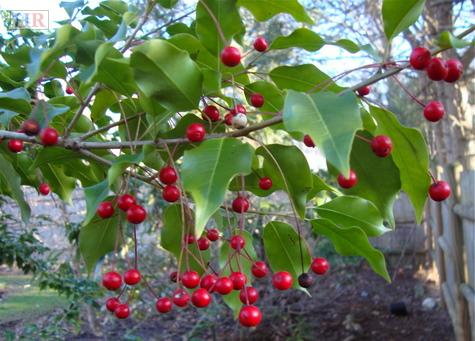The Longstalk Holly
Plant explorers of the 19th and 20th centuries introduced hundreds of eastern Asian plant species into western cultivation. Many of these plants have become so common in the American landscape, that it is difficult to imagine our gardens without them. Forsythia, weeping cherry trees, Japanese maples, Sargent crabapple and old-fashioned bleeding heart are just of few of the Asian introductions we rely on to create beauty in our gardens. The Star Magnolia, double-file viburnum, and Korean lilac are also valued contributors to North American gardens.

Other introductions are less common, and sometimes inexplicably so. One of these is Ilex pedunculosa, the longstalk holly. Native to China and Japan, this evergreen holly is a large shrub or small tree with a sturdy constitution and graceful beauty. It has a dense, upright branching habit when young that becomes more open with maturity. Plants in the wild reach heights of 30 feet, but 15 feet is typical in garden settings. It responds well to light pruning, making it adaptable to the shrub border.
The smooth, green leaves of longstalk holly are 2-3 inches long and 1½ inches wide. They are non-spiny, with a satiny sheen and gently rippled edges that catch the light, adding to the shrub’s distinction. Its most unique feature is the bright red berries that hang from one- to two-inch long slender stalks (pedicles), resembling tiny cherries. These fruits are one-quarter inch in diameter and appear in early fall. They persist on the plant well into winter, until they are eaten by birds and other wildlife. As is common in hollies, both male and female plants are needed in order for the female to set fruit.
Longstalk holly was first grown in North America from seeds planted at the Arnold Arboretum in 1907, under the direction of Charles Sprague Sargent, a plant explorer and the first director of the Arboretum. It has proven to be long-lived and extremely cold tolerant, with some of the original specimens still gracing the Arboretum landscape. It is dependably hardy through Zone 5 and has been documented as surviving temperatures as low as -18 degrees with no damage. Like all hollies, it prefers a well-drained, slightly acidic soil. It thrives in partial shade and has no serious pest or disease problems.
My own longstalk hollies were planted over 15 years ago. They were slow-growing at first, then hit their stride and are now 10-foot tall beauties that add grace and diversity to my shrub border. Their long branches are very supple, and it is amusing to watch squirrels as they try to inch their way along the swaying branches to nibble on the tasty fruits. Towards the end of winter, the only berries left uneaten are at the branch tips, and I have seen birds attempting to jump/fly up to grab a berry on their way down. How glad I am that I planted my longstalk hollies across from my kitchen window, where I can appreciate their year-long beauty and enjoy watching wildlife feasting on their fruits.
Longstalk holly is surprisingly under-used in the home landscape. Its lustrous, wavy leaves add depth and motion to the garden as they catch the light of the sun. Its shiny red, dangling berries add unique beauty and provide food for birds and its graceful form adds elegance to the shrub border. In his book, Manual of Woody Landscape Plants, Michael Dirr calls it “the most handsome of the evergreen hollies that can be grown in northern gardens”. Easily grown, disease-free, and beautiful in all seasons, longstalk holly deserves a place in every home garden.
(Joan Butler is co-owner of Enchanted Gardens, a garden and landscape design firm in Holliston, www.enchantedgardensdesign.com, and a past president of the Holliston Garden Club.)